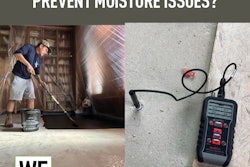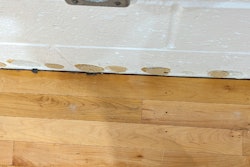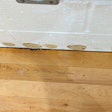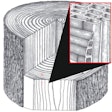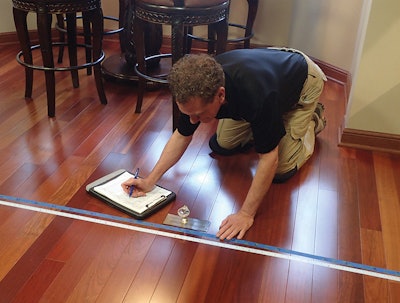
One basic skill all wood flooring pros should understand is taking measurements across a span of boards to see what the total width is compared with what should be expected. This is one of the easiest and quickest ways to determine what the condition of the flooring is (when done before installation or done during installation to check consistency) or was (when the flooring is being inspected later).
How to do it
The industry standard is to measure board spans close to 45 inches. For strip, you measure the width of a span of 20 boards (20 x 2.25 = 45). If you're dealing with a 6-inch plank, you'd measure a span across seven or eight boards (they should be a total width of 42 or 48 inches). The more multiple board measurements you take throughout the floor, the better. You shouldn't take measurements close to walls or other vertical obstructions, because expansion gaps can affect the measurements (the flooring isn't as constrained there). Note that the overall dimension of an installed floor doesn't change unless something catastrophic happens.
Before you install, put spans of boards down and measure their width. Most of your measurement should be within 1/16 inch or less. If you've got a span that measures as much as ⅛ off, there's an issue.
RELATED: One Way We Avoid Trouble: The 10-Board Measurement
You need to have measurements from multiple groups of boards. If the groups are consistently undersize or oversize by the same amount, that suggests the problem could be the flooring was milled incorrectly (milled too wet or too dry, or milled off-size). If the variation isn't consistent between groups of boards, the problem is likely the flooring gaining or losing moisture since milling, because boards with different grain patterns won't have consistent variations when they gain or lose moisture, or it's possible a different shipment was used.
Knowing the flooring is oversize or undersize can tell you, along with your moisture meter, if you should install the flooring with some space, allowing it to expand, or if you need to install it tight (or, if the flooring has swelled too much, even wait to install until it's at an acceptable moisture content). Keep in mind that customers are much more likely to call you for cupping than they are for some minor gapping.
If there's been so much moisture that the floor is buckling, multiple measurements go out the window—flooring must be firmly attached to the subfloor for multiple measurements to mean anything. Also, know that floating floors are a horse of a different color, and multiple measures of floating floors may not tell you what has happened to the flooring.
RELATED: Limit Your Liability: Avoid Moisture-Related Claims on Wood Floors















